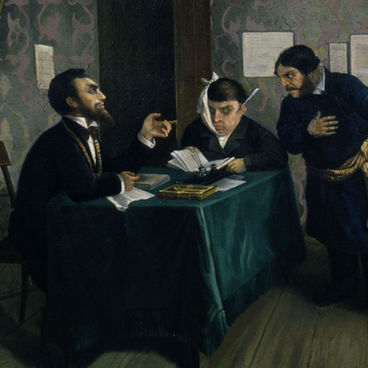The portrait depicts Marfa Ioannovna, mother of Mikhail Fyodorovich, the first Russian Tsar from the Romanov dynasty. Her secular name was Xenia Romanova. She was known as reverend nun Marfa and belonged to a noble family of landowners from Kostroma.
Xenia Ioannovna was a spouse of boyar Fyodor Romanov. He was a relative of Tsar Fyodor Ioannovich, who reigned at that time. After the tsar’s death and during Boris Godunov’s reign, the Romanovs and their relatives were placed under arrest. Godunov was afraid for his power and saw in Fyodor Nikitich, a representative of an influential family, a rival claiming the throne.
Xenia Ioannovna was separated from her children and her husband. She was forced to take the veil changing her name to Marfa; her husband was also forced to take his monastic vows under the name of Filaret. Marfa was exiled to the Onezhsky District. Initially, the exile conditions were harsh but later the control was lightened. She got an opportunity to talk with local people, who welcomed the exiled lady; her surveillance was not too strict.
The portrait presented at the museum exhibition corresponds to that time.
The nun’s iconographic type is unusual. Under Marfa Ioannovna’s black robe we can see a dress resembling the royal ‘grand apparel’. The front part of the dress is decorated with an embroidered stripe with precious stones and pearls. Marfa Ioannovna’s features imply strong character and will, intransigence and an ability to achieve her goals.
After her son Mikhail Fyodorovich was elected to the Russian throne, she blessed him to the reign. The mother had a strong influence on him. Until the end of her life, Marfa Ioannovna remained a major figure at the court, and in her son’s letters she was addressed as the ‘great mistress’.
Xenia Ioannovna was a spouse of boyar Fyodor Romanov. He was a relative of Tsar Fyodor Ioannovich, who reigned at that time. After the tsar’s death and during Boris Godunov’s reign, the Romanovs and their relatives were placed under arrest. Godunov was afraid for his power and saw in Fyodor Nikitich, a representative of an influential family, a rival claiming the throne.
Xenia Ioannovna was separated from her children and her husband. She was forced to take the veil changing her name to Marfa; her husband was also forced to take his monastic vows under the name of Filaret. Marfa was exiled to the Onezhsky District. Initially, the exile conditions were harsh but later the control was lightened. She got an opportunity to talk with local people, who welcomed the exiled lady; her surveillance was not too strict.
The portrait presented at the museum exhibition corresponds to that time.
The nun’s iconographic type is unusual. Under Marfa Ioannovna’s black robe we can see a dress resembling the royal ‘grand apparel’. The front part of the dress is decorated with an embroidered stripe with precious stones and pearls. Marfa Ioannovna’s features imply strong character and will, intransigence and an ability to achieve her goals.
After her son Mikhail Fyodorovich was elected to the Russian throne, she blessed him to the reign. The mother had a strong influence on him. Until the end of her life, Marfa Ioannovna remained a major figure at the court, and in her son’s letters she was addressed as the ‘great mistress’.



